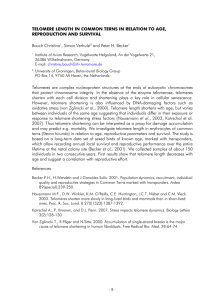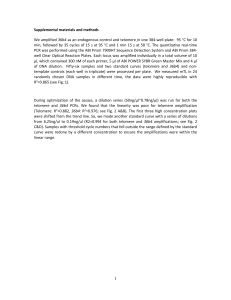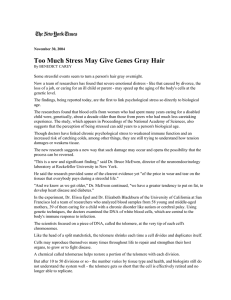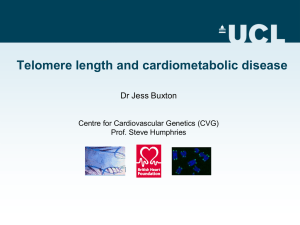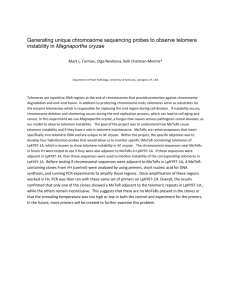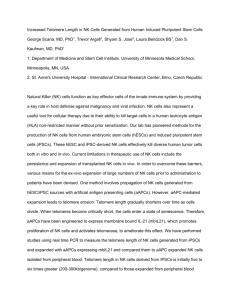Remarkable Differences in Telomere Lengths among Cloned Cattle Derived
advertisement
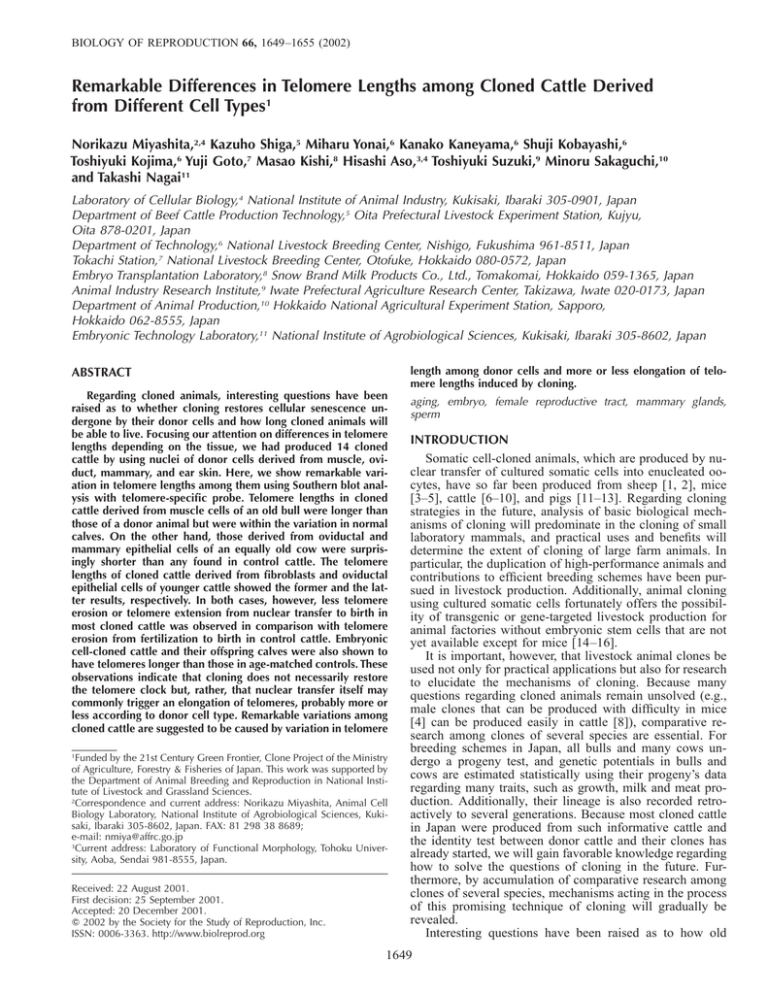
BIOLOGY OF REPRODUCTION 66, 1649–1655 (2002) Remarkable Differences in Telomere Lengths among Cloned Cattle Derived from Different Cell Types1 Norikazu Miyashita,2,4 Kazuho Shiga,5 Miharu Yonai,6 Kanako Kaneyama,6 Shuji Kobayashi,6 Toshiyuki Kojima,6 Yuji Goto,7 Masao Kishi,8 Hisashi Aso,3,4 Toshiyuki Suzuki,9 Minoru Sakaguchi,10 and Takashi Nagai11 Laboratory of Cellular Biology,4 National Institute of Animal Industry, Kukisaki, Ibaraki 305-0901, Japan Department of Beef Cattle Production Technology,5 Oita Prefectural Livestock Experiment Station, Kujyu, Oita 878-0201, Japan Department of Technology,6 National Livestock Breeding Center, Nishigo, Fukushima 961-8511, Japan Tokachi Station,7 National Livestock Breeding Center, Otofuke, Hokkaido 080-0572, Japan Embryo Transplantation Laboratory,8 Snow Brand Milk Products Co., Ltd., Tomakomai, Hokkaido 059-1365, Japan Animal Industry Research Institute,9 Iwate Prefectural Agriculture Research Center, Takizawa, Iwate 020-0173, Japan Department of Animal Production,10 Hokkaido National Agricultural Experiment Station, Sapporo, Hokkaido 062-8555, Japan Embryonic Technology Laboratory,11 National Institute of Agrobiological Sciences, Kukisaki, Ibaraki 305-8602, Japan length among donor cells and more or less elongation of telomere lengths induced by cloning. ABSTRACT Regarding cloned animals, interesting questions have been raised as to whether cloning restores cellular senescence undergone by their donor cells and how long cloned animals will be able to live. Focusing our attention on differences in telomere lengths depending on the tissue, we had produced 14 cloned cattle by using nuclei of donor cells derived from muscle, oviduct, mammary, and ear skin. Here, we show remarkable variation in telomere lengths among them using Southern blot analysis with telomere-specific probe. Telomere lengths in cloned cattle derived from muscle cells of an old bull were longer than those of a donor animal but were within the variation in normal calves. On the other hand, those derived from oviductal and mammary epithelial cells of an equally old cow were surprisingly shorter than any found in control cattle. The telomere lengths of cloned cattle derived from fibroblasts and oviductal epithelial cells of younger cattle showed the former and the latter results, respectively. In both cases, however, less telomere erosion or telomere extension from nuclear transfer to birth in most cloned cattle was observed in comparison with telomere erosion from fertilization to birth in control cattle. Embryonic cell-cloned cattle and their offspring calves were also shown to have telomeres longer than those in age-matched controls. These observations indicate that cloning does not necessarily restore the telomere clock but, rather, that nuclear transfer itself may commonly trigger an elongation of telomeres, probably more or less according to donor cell type. Remarkable variations among cloned cattle are suggested to be caused by variation in telomere Funded by the 21st Century Green Frontier, Clone Project of the Ministry of Agriculture, Forestry & Fisheries of Japan. This work was supported by the Department of Animal Breeding and Reproduction in National Institute of Livestock and Grassland Sciences. 2 Correspondence and current address: Norikazu Miyashita, Animal Cell Biology Laboratory, National Institute of Agrobiological Sciences, Kukisaki, Ibaraki 305-8602, Japan. FAX: 81 298 38 8689; e-mail: nmiya@affrc.go.jp 3 Current address: Laboratory of Functional Morphology, Tohoku University, Aoba, Sendai 981-8555, Japan. 1 Received: 22 August 2001. First decision: 25 September 2001. Accepted: 20 December 2001. Q 2002 by the Society for the Study of Reproduction, Inc. ISSN: 0006-3363. http://www.biolreprod.org aging, embryo, female reproductive tract, mammary glands, sperm INTRODUCTION Somatic cell-cloned animals, which are produced by nuclear transfer of cultured somatic cells into enucleated oocytes, have so far been produced from sheep [1, 2], mice [3–5], cattle [6–10], and pigs [11–13]. Regarding cloning strategies in the future, analysis of basic biological mechanisms of cloning will predominate in the cloning of small laboratory mammals, and practical uses and benefits will determine the extent of cloning of large farm animals. In particular, the duplication of high-performance animals and contributions to efficient breeding schemes have been pursued in livestock production. Additionally, animal cloning using cultured somatic cells fortunately offers the possibility of transgenic or gene-targeted livestock production for animal factories without embryonic stem cells that are not yet available except for mice [14–16]. It is important, however, that livestock animal clones be used not only for practical applications but also for research to elucidate the mechanisms of cloning. Because many questions regarding cloned animals remain unsolved (e.g., male clones that can be produced with difficulty in mice [4] can be produced easily in cattle [8]), comparative research among clones of several species are essential. For breeding schemes in Japan, all bulls and many cows undergo a progeny test, and genetic potentials in bulls and cows are estimated statistically using their progeny’s data regarding many traits, such as growth, milk and meat production. Additionally, their lineage is also recorded retroactively to several generations. Because most cloned cattle in Japan were produced from such informative cattle and the identity test between donor cattle and their clones has already started, we will gain favorable knowledge regarding how to solve the questions of cloning in the future. Furthermore, by accumulation of comparative research among clones of several species, mechanisms acting in the process of this promising technique of cloning will gradually be revealed. Interesting questions have been raised as to how old 1649 1650 MIYASHITA ET AL. pulse-field electrophoresis to separate long telomeric DNAs [28–30] using a program designed to ensure good separation for size between 1 and 50 kb with the FIGE Mapper electrophoresis system (Bio-Rad, Hercules, CA). The DNA was then transferred to nylon membranes by a standard Southern blotting procedure. DNA was cross-linked to the membrane with 1200 mJ of ultraviolet light. Hybridization FIG. 1. Linear regression of telomere lengths showing the decline in telomere lengths with age for 50 control cattle and positions of telomere lengths in the cloned cattle and their donor cells. Dots indicate leukocytes in control cattle, and a solid line indicates linear regression of telomere lengths. Closed symbols indicate cultured donor cells, and open symbols indicate leukocytes of their cloned calves. Squares indicate oviductal epithelial cells from an old Holstein and a Jersey cow and leukocytes of their cloned calves. Diamonds indicate mammary epithelial cells from the same Holstein cow and leukocytes of their cloned calves. A cross indicates leukocytes, sampled at 14 yr of age, of an old Japanese Black bull that provided muscle cells for cloning. Circles indicate muscle cells, sampled at 12 yr of age, of the Japanese Black bull and leukocytes of its cloned cattle. Triangles indicate skin fibroblasts from another Japanese Black bull and its cloned calves. The telomere-specific oligonucleotide (TTAGGG)3 was end-labeled at 378C for 15 min using terminal deoxynucleotidyl transferase from the DIG Oligonucleotide 39-End Labeling Kit (Roche, Mannheim, Germany). The blotted nylon membranes were prehybridized in 40 ml of DIG Easy Hyb (Roche) for 2 h at 378C, and then were hybridized in 10 ml of DIG Easy Hyb containing 50 pmol of end-labeled, telomere-specific probe for 16 h at 378C. Membranes were washed 3 times in 50 ml of 0.53 standard saline citrate (SSC; 13 SSC: 0.15 M NaCl plus 0.015 M sodium citrate) for 15 min at 378C. Chemiluminescence was performed using the DIG Luminescent Detection Kit (Roche) and exposed to x-ray film (RX-U; Fuji Photo Film, Minamiashigara, Japan). Calculation of Telomere Length Telomere length was calculated as described by Tian et al. [24] and Norwood and Dimitrov [29]. The chemiluminescence signal was acquired by a Model GS-700 Imaging Densitometer (Bio-Rad) at the highest resolution of 0.01 mm. The acquired 16-bit images were then processed by using the Molecular Analyst software (Bio-Rad). Once the distance calibration was obtained, all distances were converted to telomere lengths, and the dependence of the signal intensity on the telomere length at each point (0.01 mm) was analyzed. Mean terminal restriction fragment (TRF) size was determined as S(ODi · Li)/S(ODi) cloned animals are in terms of genetic age; how long they will be able to live and stand for milk production, reproduction, and so on; and in particular, when to use donor cells derived from old animals. It has been reported in the cloned sheep ‘‘Dolly’’ that the telomere length, which shortens with each cell division, resulting in cellular senescence [17–21], is consistent with the age of the mammary tissue used for nuclear transplantation from the 6-yr-old donor sheep and that the length is significantly shorter than that in age-matched control sheep [22]. This suggests that Dolly may not achieve a full, normal life span. On the other hand, in cases of cloned cattle produced from near-senescent fibroblasts, extension of telomere lengths, in which telomere lengths in cloned cattle were the same as or longer than those in newborn normal calves, has been reported [23]. Tian et al. [24], Wakayama et al. [5], and Betts et al. [25] have also reported normal telomere lengths in clone animals derived from fibroblasts and cumulus cells. Therefore, the question of the discrepancy between Dolly’s shortened telomere and others’ restored telomeres remains. The present study was conducted to determine the effects of cloning on telomeres. Focusing our attention on differences in telomere lengths depending on the tissue [26, 27], we had produced cloned cattle from reconstructed embryos with nuclei of epithelial cells from oviduct and mammary gland, skin fibroblasts, and muscle cells [8, 9]. In the present study, we examine variation in telomere lengths in these cloned cattle, and we discuss the effect of cloning on telomere length. MATERIALS AND METHODS DNA Isolation and Southern Blot Analysis The DNA from leukocytes or cultured cells was prepared with the SDS-phenol-proteinase K extraction methods, and equal amounts of DNA (1 mg) were digested by both the restriction enzyme AluI and HinfI. Samples, 1-kilobase (kb) ladder marker, and 5-kb ladder marker were then loaded on a 1% (w/v) agarose gel (15 3 15 cm). The gels were run by where ODi is signal intensity and Li is the telomere length at each point i (0.01 mm) within the lane. Sums were calculated over the range 3–50 kb. Culture of Senescent Cells To determine a critical telomere length in bovine somatic cells, telomere erosion was examined in culture using a clonal bovine intramuscular preadipocyte (BIP) line [31]. The BIP cells were cultured in Dulbecco modified Eagle medium (Gibco BRL, Grand Island, NY) plus 10% fetal bovine serum and antibiotics at 378C in a humidified atmosphere of 5% CO2 and 95% air. For each passage, cells were cultured until confluency, were disaggregated by incubation in a 0.02% trypsin and 0.01% EDTA solution, and were allocated to new dishes for further passage. Normally, each passage lasted approximately 3 days. The cell line was maintained routinely until the cells exhibited features of replicative senescence and the number of cells could no longer increase. Statistical Analysis The mean TRF analyses in cloned cattle were repeated at least 2 times, and the average is shown in this paper. Because the methods for measuring mean TRF sizes were reported to have an error of approximately 0.3 kb in humans [30] and telomeres in cattle were demonstrated to be 2 times longer than those of humans in this study, when differences between two measurements for the same sample were beyond 0.5 kb, more measurements were carried out until the difference between two measurements was within 0.5 kb. Linear regression of mean TRF sizes in 50 normal Japanese Black cattle against age were analyzed with the least-squares method. Differences among mean TRF sizes in the donor cells, cloned cattle, control cattle, and control sperm were analyzed by Student t-test. RESULTS Telomere Lengths in Normal Cattle and Senescent Cells To calibrate the telomere clock in normal cattle, telomere erosion in vivo was analyzed using leukocytes from 50 normal Japanese Black cattle (age, 0–18 yr; Fig. 1). In newborn calves, the mean sizes of the terminal telomere fragments obtained by cutting with restriction enzymes (i.e., mean TRF) were found to be 19.0–21.9 kb (20.43 6 0.28 kb), whereas in two 18-yr-old animals, which were regard- TELOMERE LENGTH VARIATIONS IN CLONED CATTLE ed as aged, the mean TRF sizes were 15.1 and 16.8 kb (Fig. 2A). Then, the analysis yielded a significant linear regression of telomere lengths (LRTL): The mean TRF size regression was 20.23 kb/yr 1 20.54 kb (r2 5 0.56, P , 0.01). The mean TRF sizes of bovine spermatozoa were 22.1–23.9 kb (23.0 6 0.28 kb) (Fig. 2A). Because the mean TRF sizes of spermatozoa in humans are kept longer than those of any tissues beyond generation and then hypothesized as initial lengths of telomere erosion [19], telomere erosion from the beginning of fertilization to birth in cattle was also, thus, revealed to be significantly apparent (P , 0.01) and approximately 2.6 kb. On the other hand, to determine a critical telomere length in bovine somatic cells, telomere erosion in culture was examined using a clonal BIP line that exhibited a fibroblastic appearance and abundant replicative capacity [31]. After 60 passages of culture, BIP cells exhibited features of cellular senescence and almost arrested their proliferation. In such senescent cells, the mean TRF size had also stopped decreasing at 9.7 kb (Fig. 2A). Telomere Lengths in Cloned Cattle Derived from Epithelial Cells of an Old Cow We produced 5 and 1 cloned cattle by nuclear transfer of cultured oviductal epithelial cells and mammary epithelial cells, respectively, from a 13-yr-old Holstein cow [9] (Table 1). The mean TRF sizes in all 6 newborn cloned calves were significantly smaller (P , 0.01) than those in age-matched controls and surprisingly smaller than those in 18-yr-old control animals (Figs. 1 and 2B). In terms of the age-dependent LRTL, estimated ages taken from leukocytes of cloned calves derived from Holstein oviductal and mammary epithelial cells (as an index of aging not of the whole body but, rather, only of leukocytes) were surprisingly old and approximately 30–35 and 29 yr, respectively (Fig. 3), regardless of the actual bovine lifetime of 15–20 yr at most. However, all of them remained alive and normal at 22–25 mo of age, except that one derived from mammary epithelial cells was slaughtered for deformity. On the other hand, the mean TRF sizes of their donor cells were also revealed to be much shorter than those of leukocytes in age-matched controls in LRTL terms. Telomere erosions from nuclear FIG. 2. Representative analysis of telomeres in cloned cattle. Telomeres of cells for which sources are not described are from leukocytes. A) Telomeres in control spermatozoa (lane 1), calf (lane 2), 18-yr-old cattle (lane 3), and senescent cultured cells (lane 4) were demonstrated. B) Telomeres in cloned cattle (lanes 6, 7, 9, and 10) produced from cultured oviductal epithelial cells (lanes 5 and 8) were demonstrated. Lanes 5–7 were derived from a 6-yr-old Jersey cow. Lanes 8–10 were derived from a 13-yrold Holstein cow. C and D) Telomeres in cloned calves (lanes 13, 14, 16, and 17) produced from cultured muscle (lane 12) and skin fibroblast (lane 15) cells, respectively, were demonstrated. Lanes 12–14 were derived from a 12-yr-old bull (lane 11). Lanes 15–17 were derived from a 2-yrold bull. E) Telomeres in embryonic cell-cloned cattle (lanes 19 and 20) and her offspring calf (lane 21) were demonstrated. The telomere lengths were much longer than those of a control calf (lane 18). transfer to birth were revealed to be 1.5–2.7 kb (Table 1) and were the same as or less than telomere erosion from fertilization to birth in normal cattle. Telomere Length in Cloned Cattle Derived from Muscle Cells of an Old Bull The mean TRF sizes of leukocytes from 2 newborn cloned calves that were produced by nuclear transfer of cultured cells derived from the muscle tissue of a 12-yr-old (as of August 1997) Japanese Black bull [8] were within variation among the age-matched control calves (Figs. 1 and 2C). These cloned cattle remained alive and normal at 24–29 mo of age and had calves by artificial insemination using their spermatozoa. The mean TRF sizes of their donor cells, regardless of 6 passages of culture before nuclear transfer, were be much longer than those of leukocytes from TABLE 1. Telomere lengths of somatic cell-cloned cattle and telomere length change from nuclear transfer to birth. Donor cell type and mean TRF (kb) Cloned cattle ID 1651 Mean TRF (kb) 15.2 (Oviductal epithelial cells from a 13-yr-old Holstein cow) ovh1 12.9 ovh2 13.4 ovh3 13.2 ovh4 13.7 ovh5 12.5 16.3 (Mammary epithelial cells from a 13-yr-old Holstein cow) meh1 14.3 16.9 (Oviductal epithelial cells from a 6-yr-old Jersey cow) ovj1 15.9 ovj2 14.9 ovj3 16.0 ovj4 14.9 20.1 (Muscle cells from a 12-yr-old Japanese Black bull) mus1 19.6 mus2 19.9 18.2 (Skin fibroblasts from a 2-yr-old Japanese Black bull) ear1 20.0 ear2 20.4 Telomere length change (kb) Current status 22.3 21.8 22.0 21.5 22.7 Live Live Live Live Live 22.0 Slaughter for deformity 21.0 22.0 20.9 22.0 Live Live Live Live 20.5 20.2 Live Live 11.8 12.2 Slaughter for research Died of dystocia 1652 MIYASHITA ET AL. those in age-matched controls and surprisingly smaller than those in 18-yr-old control animals (Figs. 1 and 2B). Telomere erosions from nuclear transfer to birth were 0.9–2.0 kb (Table 1) and were less than telomere erosion from fertilization to birth in normal cattle. On the other hand, the mean TRF sizes of leukocytes from 2 cloned cattle that were produced by nuclear transfer of cultured skin cells derived from an ear of a 2-yr-old Japanese Black bull and their donor cells were compared with those of leukocytes obtained from age-matched controls. The mean TRF sizes in the newborn cloned calves were within variation among the age-matched control calves, just as in cloned cattle derived from muscle cells of an old bull (Figs. 1 and 2D). One of the cloned calves was very heavy in body weight (63 kg) compared to the standard body weight for male calves of this breed (20–30 kg) and died shortly after birth because of dystocia at parturition; the other cloned calf was normal in body weight (27 kg) and slaughtered for histopathological research (Table 1). Regardless of a few passages of culture before nuclear transfer, the mean TRF sizes of donor cells from ear skin were to be much smaller than those of leukocytes in the newborn cloned calves. Thus, telomere extension might have occurred from nuclear transfer to birth. The extent of changes in telomere lengths from nuclear transfer to birth was significantly different among their donor cell types of epithelial cells, muscle cells, and fibroblasts (P , 0.01). Telomere Length in Embryonic Cell-Cloned Cattle FIG. 3. Cloned cattle produced by nuclear transfer of cultured oviductal epithelial cells from a 13-yr-old Holstein cow and a 6-yr-old Jersey cow. A) Holstein clones at 12 mo of age. B) Jersey clones at 10 mo of age. cattle at the corresponding age in LRTL terms. Therefore, less telomere erosion from nuclear transfer to birth was revealed in comparison with that from fertilization to birth in normal cattle. Telomere Length in Cloned Cattle Derived from Cultured Cells of Younger Cattle We produced 4 cloned cattle by nuclear transfer of cultured oviductal epithelial cells from a 6-yr-old Jersey cow [9]. Like cloned calves derived from epithelial cells of an old Holstein cow, the mean TRF sizes in all 4 newborn cloned calves were significantly smaller (P , 0.01) than We investigated telomere lengths in embryonic cellcloned cattle that had been produced by nuclear transfer of the nuclei of 28- to 49-cell stage blastomeres to enucleated oocytes. All of 6 embryonic cell-cloned cattle we tested had significantly longer telomeres than age-matched controls (P , 0.01), and their offspring calves, which were obtained by artificial insemination of normal spermatozoa to female embryonic cell-cloned cattle, also had telomere lengths somewhere in between those of age-matched control calves and embryonic cell-cloned cattle (Fig. 2E and Table 2). DISCUSSION To our knowledge, the present study is the first to show that remarkable variation exists among telomere lengths in cloned cattle produced from donor cells derived from 4 different kinds of tissue. Particularly, telomere lengths in TABLE 2. Telomere lengths and cloning data of embryonic cell-cloned cattle and their offspring. Clone ID Sex Embryonic cell-cloned cattle E61 M E62 M E63 M EC1 F EC2 F EC3 F Offspringb ES1c M ES2d M a Breed Days postcoitum of donor cell (day) Development stage of donor cell (cell) Mean TRF (kb) JBa JB JB JB JB JB 5.0 5.0 5.0 5.5 5.5 5.0 34 34 34 49 49 28 23.8 23.3 22.7 21.7 22.6 26.2 JB JB 24.6 21.0 JB, Breed of Japanese Black. Offspring were obtained by artificial insemination of normal spermatozoa to female embryonic cell-cloned cattle. c Dam of ES1 was EC3. d Dam of ES2 was EC2. b TELOMERE LENGTH VARIATIONS IN CLONED CATTLE cloned calves derived from epithelial cells were surprisingly shorter than those in all control cattle that we tested. In the case of Dolly, the mean TRF size was reported to be consistent with those of her donor cells (i.e., cultured mammary epithelial cells) and smaller than those of the agematched control sheep [22]. Lanza et al. [23] reported that the mean TRF sizes in cloned cattle produced from senescent fibroblasts were much longer than those in their donor cells, and those authors concluded that cloning using bovine fibroblasts restores the telomere clock. It was suggested that the difference between Dolly and their cloned cattle might be due to species differences and/or to differences in nuclear transfer techniques or donor cell types [23]. Furthermore, Tian et al. [24] reported that telomere lengths in cloned cattle derived from fibroblasts and cumulus cells were normal and pointed out that Dolly’s short telomeres likely are an exception, but without referring to the different cell types used as donor cells. However, our results showed both remarkably short telomere lengths in cloned cattle derived from epithelial cells and normal telomere lengths in cloned cattle derived from muscle cells and fibroblasts. Therefore, it can be suggested that Dolly’s short telomeres are not an exception but, rather, that different donor cell types might lead to different telomere lengths in the resultant cloned cattle. The number of samples in the present study was limited and the conditions for comparison were inequitable, but the most likely explanation for the remarkable variation among telomere lengths in our cloned cattle was that it reflected the telomere length variation of their donor cells and the extent of telomere length change induced by cloning. First, the variation among donor cells may be caused by cell typespecific factors in vivo, e.g., frequencies of cell division in each tissue and intracellular environments such as a concentration of superoxide that is detrimental to DNA helices, and so on. It was suggested that the telomere erosion rate of the oviductal and mammary epithelial cells in vivo may be much more rapid than that in leukocytes, and that the extremely shortened telomere lengths of resultant donor cells may lead to the remarkably short telomere lengths of the cloned calves. In contrast, it was suggested that telomere lengths of the muscle cells could be retained even in the old donor bull, because the donor cells were possibly derived from muscle satellite cells that play a role in restoring injured muscle tissue and are inactive for cell division except when performing that function. Therefore, telomere lengths of the muscle cells might lead to a longer mean TRF of leukocytes in the cloned calves than that in the donor bull. Second, it was also suggested that the effect of aging in vivo of donor cattle might contribute to the telomere length variation of donor cells, because the difference between telomere lengths in oviductal epithelial cells from 2 cows in the present study was reflected by the different ages of the cows. Furthermore, the difference might result in telomere length variation among cloned cattle that is significantly regressive (r2 5 0.840, P , 0.01). The possibility that telomere length variation of donor cells was contributed to by the genetic background of the donor cattle was not excluded, because variation among telomere lengths in the leukocytes of control cattle was not so small. On the other hand, telomere length variation among donor cells might not be induced by culture so much, because the donor cells were used after only a few passages. Not only initial telomere lengths in donor cells but also the extent of telomere length change induced after cloning might lead to a remarkable variation among telomere 1653 lengths in cloned cattle. In all previous reports except the case of Dolly [22], it was demonstrated that shortened telomeres in donor fibroblasts and cumulus cells both extended and restored from nuclear transfer to birth; therefore, normal telomere lengths in cloned calves were obtained [23– 25]. Betts et al. [25] pointed out that the rebuilding of shorter telomere lengths in donor cells could be due to telomerase activities, which are detected as early as the blastocyst stage in reconstructed embryos. The present study showed that some cloned cattle had longer telomere lengths than those of their donor cells, and that others had telomere lengths just a bit shorter than those of their donor cells. Additionally, the extent of telomere length changes from nuclear transfer to birth were significantly different among donor cell types (P , 0.01). It is of interest that less telomere erosion or telomere extension from nuclear transfer to birth was observed in most cloned cattle in comparison with telomere erosion from fertilization to birth in control cattle (2.6 kb). Thus, it was suggested that cloning does not necessarily restore the telomere clock but, rather, may commonly trigger an elongation of telomere lengths, probably more or less according to cell types. Not only in cattle but also in humans, telomere lengths were reported to decrease from 22 kb in spermatozoa to 10 kb in newborn-baby leukocytes [17]. Hence, it is most probable that telomeres also decrease from fertilization to birth in sheep. If so, then Dolly’s telomere length, which was the same as that of the donor mammary epithelial cell, might elongate transiently after cloning, resulting in compensation for the loss during embryo-fetus development. The exact explanation for the difference among donor cell types in the extent of telomere length elongation from nuclear transfer to birth is unclear at this moment. In humans, it was reported that telomerase activities are not detected in most somatic cells except for a part of the stem cells and fetal cells [32–34], and that telomerase activities even in telomerase-positive somatic cells are lost quickly by culture and particularly during passage [35]. In cattle, similar results were obtained [25], and telomerase activities in oviduct, mammary, muscle, and ear skin tissue were very weak or not detected in our study (data not shown). Thus, it was suggested that the difference among donor cell types in telomere length elongation was not caused by telomerase activities taken from donor cells. It may, instead, be partially explained by a possibility that donor cell type-specific sensitivities to telomerase, based on telomere-binding proteins [36, 37], lead to the difference in the extent of telomere elongation in reconstructed embryos. For example, telomere-binding protein TRF1, which inhibits telomerase activities, was expressed differentially according to the tissue type [37]. To confirm whether telomere elongation is only specific to somatic cell-cloned cattle, we investigated telomere lengths in embryonic cell-cloned cattle that had been produced by nuclear transfer of blastomeres to enucleated oocytes. They are regarded as being homogeneous to normal cattle, because totipotent cells in germline were used as their donor cells. All of 6 embryonic cell-cloned cattle and their offspring calves that we tested had significantly (P , 0.01) longer telomeres than the age-matched controls. These results might indicate that elongation of telomeres did not result from cloning with ‘‘somatic’’ cells but, rather, was induced by the technique of nuclear transfer itself. To determine a critical telomere length in bovine somatic cells, telomere erosion was examined in culture using a clonal BIP cell line, in which the mean TRF size had also 1654 MIYASHITA ET AL. stopped decreasing at 9.7 kb. This critical length is longer than that from human fibroblast [20] and leukocytes [38] but is shorter than the telomere lengths of sterile mice derived from successive crossing of mice lacking telomerase RNA and exhibiting decreased proliferation in highly proliferative organs [39, 40]. Because the mean TRF sizes of leukocytes in old cattle were much longer than the critical length found in the BIP line, it may be difficult to relate telomere erosion to senescence in normal cattle. Therefore, it was indicated that cloned calves derived from epithelial cells could live regardless of the ages estimated from telomeres in leukocytes, which were surprisingly old at approximately 24–33 yr. However, it is possible that cloned cattle produced from oviductal and mammary epithelial cells may lose function sooner in tissues with cells regulated at a high rate of telomere erosion and, consequently, die young because of their remarkably short telomeres. It is often said that we must take care of the decreased genetic variation in the livestock population and the resultant increased risk of inbreeding depression and genetic disease induced by the overdiffusion of cloning. Likewise, it may be important to be careful of telomere lengths, not only for individual cloned animals but also for whole species. If cloned animals and their offspring that had short telomeres were selectively reproduced for their high performance and disseminated without due care, the whole species might become short-lived and, in some cases, face extinction. When applying cloning techniques in the livestock industry, we must check telomere lengths and take them into account, for the sake of longevity, when making mating plans. ACKNOWLEDGMENTS We thank Y. Nagamine for statistical analysis and helpful advice, Y. Sasae and Y. Yamada for insightful discussions and providing samples, and T. Takenouchi, M. Higuchi, and Y. Shingai for advice and assistance. REFERENCES 1. Campbell KH, McWhir J, Ritchie WA, Wilmut I. Sheep cloned by nuclear transfer from a cultured cell line. Nature 1996; 380:64–66. 2. Wilmut I, Schnieke AE, McWhir J, Kind AJ, Campbell KH. Viable offspring derived from fetal and adult mammalian cells. Nature 1997; 385:810–813. 3. Wakayama T, Perry AC, Zuccotti M, Johnson KR, Yanagimachi R. Full-term development of mice from enucleated oocytes injected with cumulus cell nuclei. Nature 1998; 394:369–374. 4. Wakayama T, Yanagimachi R. Cloning of male mice from adult tailtip cells. Nat Genet 1999; 22:127–128. 5. Wakayama T, Shinkai Y, Tamashiro KL, Niida H, Blanchard DC, Blanchard RJ, Ogura A, Tanemura K, Tachibana M, Perry AC, Colgan DF, Mombaerts P, Yanagimachi R. Cloning of mice to six generations. Nature 2000; 407:318–319. 6. Cibelli JB, Stice SL, Golueke PJ, Kane JJ, Jerry J, Blackwell C, Ponce de Leon FA, Robl JM. Cloned transgenic calves produced from nonquiescent fetal fibroblasts. Science 1998; 280:1256–1258. 7. Kato Y, Tani T, Sotomaru Y, Kurokawa K, Kato J, Doguchi H, Yasue H, Tsunoda Y. Eight calves cloned from somatic cells of a single adult. Science 1998; 282:2095–2098. 8. Shiga K, Fujita T, Hirose K, Sasae Y, Nagai T. Production of calves by transfer of nuclei from cultured somatic cells obtained from Japanese black bulls. Theriogenology 1999; 52:527–535. 9. Goto Y, Kaneyama K, Kobayashi S, Imai K, Shin-noh M, Tsujino T, Nakano T, Matsuda S, Nakane S, Kojima T. Birth of cloned calves derived from cultured oviductal epithelial cells of a dairy cow. Anim Sci J 1999; 70:243–245. 10. Kubota C, Yamakuchi H, Todoroki J, Mizoshita K, Tabara N, Barber M, Yang X. Six cloned calves produced from adult fibroblast cells after long-term culture. Proc Natl Acad Sci U S A 2000; 97:990–995. 11. Onishi A, Iwamoto M, Akita T, Mikawa S, Takeda K, Awata T, Hanada H, Perry AC. Pig cloning by microinjection of fetal fibroblast nuclei. Science 2000; 289:1188–1190. 12. Polejaeva IA, Chen SH, Vaught TD, Page RL, Mullins J, Ball S, Dai Y, Boone J, Walker S, Ayares DL, Colman A, Campbell KH. Cloned pigs produced by nuclear transfer from adult somatic cells. Nature 2000; 407:86–90. 13. Betthauser J, Forsberg E, Augenstein M, Child L, Eilertsen K, Enos J, Forsythe T, Golueke P, Jurgella G, Koppang R, Lesmeister T, Mallon K, Mell G, Misica P, Pace M, Pfister-Genskow M, Strelchenko N, Voelker G, Watt S, Thompson S, Bishop M. Production of cloned pigs from in vitro systems. Nat Biotechnol 2000; 18:1055–1059. 14. Colman A. Dolly, Polly, and other ‘ollys’: likely impact of cloning technology on biomedical uses of livestock. Genet Anal 1999; 15: 167–173. 15. Baguisi A, Behboodi E, Melican DT, Pollock JS, Destrempes MM, Cammuso C, Williams JL, Nims SD, Porter CA, Midura P, Palacios MJ, Ayres SL, Denniston RS, Hayes ML, Ziomek CA, Meade HM, Godke RA, Gavin WG, Overstrom EW, Echelard Y. Production of goats by somatic cell nuclear transfer. Nat Biotechnol 1999; 17:456– 461. 16. McCreath KJ, Howcroft J, Campbell KH, Colman A, Schnieke AE, Kind AJ. Production of gene-targeted sheep by nuclear transfer from cultured somatic cells. Nature 2000; 405:1066–1069. 17. Harley CB, Futcher AB, Greider CW. Telomeres shorten during ageing of human fibroblasts. Nature 1990; 345:458–460. 18. Hastie ND, Dempster M, Dunlop MG, Thompson AM, Green DK, Allshire RC. Telomere reduction in human colorectal carcinoma and with aging. Nature 1990; 346:866–868. 19. Counter CM, Avilion AA, LeFeuvre CE, Stewart NG, Greider CW, Harley CB, Bacchetti S. Telomere shortening associated with chromosome instability is arrested in immortal cells which express telomerase activity. EMBO J 1992; 11:1921–1929. 20. Allsopp RC, Vaziri H, Patterson C, Goldstein S, Younglai EV, Futcher AB, Greider CW, Harley CB. Telomere length predicts replicative capacity of human fibroblasts. Proc Natl Acad Sci U S A 1992; 89: 10114–10118. 21. Vaziri H, Dragowska W, Allsopp RC, Thomas TE, Harley CB, Lansdorp PM. Evidence for a mitotic clock in human hematopoietic stem cells: loss of telomeric DNA with age. Proc Natl Acad Sci U S A 1994; 91:9857–9860. 22. Shiels PG, Kind AJ, Campbell KH, Waddington D, Wilmut I, Colman A, Schnieke AE. Analysis of telomere lengths in cloned sheep. Nature 1999; 399:316–317. 23. Lanza RP, Cibelli JB, Blackwell C, Cristofalo VJ, Francis MK, Baerlocher GM, Mak J, Schertzer M, Chavez EA, Sawyer N, Lansdorp PM, West MD. Extension of cell life-span and telomere length in animals cloned from senescent somatic cells. Science 2000; 288:665– 669. 24. Tian XC, Xu J, Yang X. Normal telomere lengths found in cloned cattle. Nat Genet 2000; 26:272–273. 25. Betts DH, Bordignon V, Hill JR, Winger Q, Westhusin ME, Smith LC, King WA. Reprogramming of telomerase activity and rebuilding of telomere length in cloned cattle. Proc Natl Acad Sci U S A 2001; 98:1077–1082. 26. Prowse KR, Greider CW. Developmental and tissue-specific regulation of mouse telomerase and telomere length. Proc Natl Acad Sci U S A 1995; 92:4818–4822. 27. Coviello-McLaughlin GM, Prowse KR. Telomere length regulation during postnatal development and ageing in Mus spretus. Nucleic Acids Res 1997; 25:3051–3058. 28. Kipling D, Cooke HJ. Hypervariable ultra-long telomeres in mice. Nature 1990; 347:400–402. 29. Norwood D, Dimitrov DS. Sensitive method for measuring telomere lengths by quantifying telomeric DNA content of whole cells. Biotechniques 1998; 25:1040–1045. 30. Kozik A, Bradbury EM, Zalensky A. Increased telomere size in sperm cells of mammals with long terminal (TTAGGG)n arrays. Mol Reprod Dev 1998; 51:98–104. 31. Aso H, Abe H, Nakajima I, Ozutsumi K, Yamaguchi T, Takamori Y, Kodama A, Hoshino F, Takano S. A preadipocyte clonal line from bovine intramuscular adipose tissue: nonexpression of GLUT-4 protein during adipocyte differentiation. Biochem Biophys Res Commun 1995; 213:369–375. 32. Counter CM, Hirte HW, Bacchetti S, Harley CB. Telomerase activity in human ovarian carcinoma. Proc Natl Acad Sci U S A 1994; 91: 2900–2904. 33. Hiyama E, Hiyama K, Yokoyama T, Matsuura Y, Piatyszek MA, Shay JW. Correlating telomerase activity levels with human neuroblastoma outcomes. Nat Med 1995; 1:203–205. TELOMERE LENGTH VARIATIONS IN CLONED CATTLE 34. Tahara H, Nakanishi T, Kitamoto M, Nakashio R, Shay JW, Tahara E, Kajiyama G, Ide T. Telomerase activity in human liver tissues: comparison between chronic liver disease and hepatocellular carcinomas. Cancer Res 1995; 55:2734–2736. 35. Wright WE, Piatyszek MA, Rainey WE, Byrd W, Shay JW. Telomerase activity in human germline and embryonic tissues and cell. Dev Genet 1996; 18:173–179. 36. Steensel BV, Lange TD. Control of telomere length by the human telomeric protein TRF1. Nature 1997; 385:740–743. 37. Broccoli D, Chong L, Oelmann S, Fernald AA, Marziliano N, van Steensel B, Kipling D, Le Beau MM, de Lange T. Comparison of the 1655 human and mouse genes encoding the telomeric protein, TRF1: chromosomal localization, expression and conserved protein domains. Hum Mol Genet 1997; 6:69–76. 38. Vaziri H, Schachter F, Uchida I, Wei L, Zhu X, Effros R, Cohen D, Harley CB. Loss of telomeric DNA during aging of normal and trisomy 21 human lymphocytes. Am J Hum Genet 1993; 52:661–667. 39. Blasco MA, Lee HW, Hande MP, Samper E, Lansdorp PM, DePinho RA, Greider CW. Telomere shortening and tumor formation by mouse cells lacking telomerase RNA. Cell 1997; 91:25–34. 40. Lee HW, Blasco MA, Gottlieb GJ, Horner JW II, Greider CW, DePinho RA. Essential role of mouse telomerase in highly proliferative organs. Nature 1998; 392:569–574.
